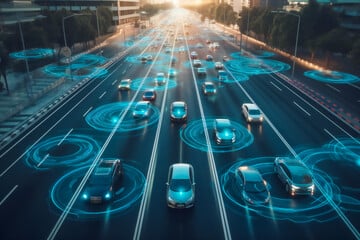Introduction to AD/ADAS: A Comprehensive Guide to the Future of Driving
Read Time 8 mins | Written by: Anuj Kharnal

The automotive world is at the cusp of a revolutionary change, with Automated Driving (AD) and Advanced Driver Assistance Systems (ADAS) leading the charge. As we move towards a future where vehicles are expected to drive themselves, it's essential to understand what these terms mean, their significance, and the technologies powering them. This comprehensive guide serves as a cornerstone to explore the exciting domain of AD and ADAS.
What are AD and ADAS?
Automated Driving (AD)
Automated Driving refers to the technology that enables vehicles to operate without human intervention. It encompasses a range of driving tasks, from steering and braking to complex decision-making, like overtaking and navigating through traffic. Automated driving is categorized into different levels (0-5), depending on the extent of automation involved.
Advanced Driver Assistance Systems (ADAS)
Unlike full automation, ADAS aims to assist the driver rather than replace them. ADAS includes features like lane departure warnings, adaptive cruise control, and parking assistance. These systems use various sensors and algorithms to interpret the vehicle's surroundings and act accordingly, thereby enhancing safety and driving comfort.
Importance of AD and ADAS
Automated Driving (AD) and Advanced Driver Assistance Systems (ADAS) are not just about technological advancement; they are also about solving real-world problems that have plagued road transportation for decades. Here are some of the most compelling reasons why AD and ADAS are important.
Safety
Reducing Human Error
Human error is a leading cause of road accidents, contributing to nearly 94% of all crashes according to the National Highway Traffic Safety Administration. AD and ADAS have the potential to dramatically reduce this figure. By automating driving tasks, these systems can eliminate mistakes caused by factors like impaired judgment, distracted driving, and fatigue.
Real-time Decision Making
AD and ADAS systems can analyze real-time data faster than a human driver, making rapid decisions that can prevent accidents. For instance, an ADAS-enabled vehicle can detect a pedestrian crossing the road and apply the brakes faster than a human could react.
Advanced Warning Systems
Features like lane-departure warnings, collision-avoidance systems, and blind-spot monitoring provide drivers with advance warnings, giving them more time to react and take corrective action.
Efficiency
Fuel Optimization
AD and ADAS can significantly improve fuel efficiency. Automated systems can optimize driving parameters like speed and acceleration based on real-time traffic conditions, leading to more economical fuel consumption.
Traffic Flow Management
By communicating with other vehicles and traffic management systems, AD and ADAS can contribute to smoother traffic flow. This reduces congestion and decreases the time people spend on the road, thereby improving overall productivity.
Environmentally Friendly
Less idling and more efficient driving also mean lower emissions, making AD and ADAS technologies crucial players in the drive towards more sustainable transportation.
Accessibility
Mobility for All
One of the most heartening prospects of automated driving is its potential to provide mobility solutions for those who are unable to drive due to age, disability, or other impairments. Self-driving cars could give these individuals a newfound sense of freedom and independence.
Simplified Driving
Advanced assistance features can make driving less intimidating for new or less-skilled drivers. Features like parking assistance and traffic-jam assist can help drivers gain confidence behind the wheel.
Public Transportation
Automation could revolutionize public transportation systems. Self-driving buses and taxis could offer more flexible and efficient services, making public transit a more attractive option and reducing reliance on individual car ownership.
Technologies Involved
Understanding AD and ADAS is incomplete without delving into the technologies that power these advanced systems. From sensors to communication technologies, let's take a closer look at the building blocks of automated driving.
Sensors
Cameras
Cameras are the eyes of any AD/ADAS system, providing crucial visual data. These cameras can recognize traffic signs, lane markings, and other objects on the road. Advanced systems often use multiple cameras positioned at various points around the vehicle to create a 360-degree view.
Radar
Radar (Radio Detection and Ranging) uses radio waves to detect objects, their distance, and their speed. It is especially useful in adverse weather conditions, such as rain or fog, where cameras might be less effective. Radar is commonly used in features like adaptive cruise control to maintain a safe following distance.
LiDAR
LiDAR (Light Detection and Ranging) uses laser beams to create a detailed 3D map of the vehicle's surroundings. It is particularly useful for object detection and collision avoidance. While LiDAR offers more precise measurements than radar, it is generally more expensive and sensitive to environmental conditions.
Software Algorithms
Machine Learning
Machine learning algorithms are at the heart of decision-making in AD/ADAS systems. These algorithms can learn from vast datasets to predict outcomes and make real-time decisions. For example, machine learning can be used to predict the behavior of a pedestrian or another vehicle based on historical data.
Sensor Fusion
Sensor fusion is the art of combining data from multiple sensors to create a comprehensive understanding of the environment. This is crucial because no single sensor is perfect; each has its limitations. Sensor fusion compensates for these limitations by combining data to provide a more accurate and reliable view.
Communication Technologies
V2V (Vehicle-to-Vehicle)
V2V technologies enable vehicles to communicate with each other directly. This is crucial for cooperative driving scenarios, like platooning, where multiple vehicles travel closely together at high speeds. V2V can also warn drivers about upcoming road conditions or hazards that are not yet visible.
V2I (Vehicle-to-Infrastructure)
V2I technologies enable vehicles to communicate with road infrastructure such as traffic lights, road signs, and sensors embedded in the road. This allows for better traffic management and can provide the driver with valuable information, such as optimal driving speeds to hit green lights all the way.
Future Trends
As we look toward the horizon, several emerging trends promise to shape the landscape of AD and ADAS. These trends not only signify technological advancements but also reflect shifts in regulatory frameworks and societal attitudes.
Increased Automation
Toward Level 5 Automation
While we currently see vehicles with Level 2 and Level 3 automation on the roads, efforts are underway to achieve Level 4 and eventually Level 5—fully automated driving without any human intervention. Companies like Waymo and Tesla are spearheading these initiatives, conducting extensive tests in controlled and real-world environments.
Evolution of ADAS
ADAS features are becoming increasingly sophisticated. What started as basic systems like lane-departure warnings and parking assistance are evolving into more advanced features such as traffic-jam assist and highway autopilot. These advancements serve as stepping stones toward full automation.
Regulatory Changes
Safety Standards
As AD and ADAS technologies mature, regulatory bodies are focusing on creating comprehensive safety standards. These guidelines will serve to ensure that automated systems meet rigorous safety requirements, minimizing the risk of malfunctions or errors.
Data Privacy and Security
With the growing reliance on data collection and processing, regulatory bodies are also emphasizing the importance of data privacy and cybersecurity. This aims to protect users from unauthorized data access and ensure the secure operation of AD and ADAS systems.
Integration with Other Technologies
Advent of 5G
The rollout of 5G networks is expected to significantly impact AD and ADAS technologies. The low latency and high bandwidth of 5G will facilitate more efficient and reliable vehicle-to-vehicle and vehicle-to-infrastructure communications.
IoT and Smart Cities
The Internet of Things (IoT) and the development of smart cities are expected to provide a supportive ecosystem for AD and ADAS. Imagine smart traffic lights that communicate directly with vehicles to optimize traffic flow or sensors embedded in road infrastructure that provide real-time data to assist autonomous driving.
AI and Edge Computing
The integration of artificial intelligence (AI) and edge computing promises to make AD and ADAS systems more intelligent and responsive. While AI enables better decision-making, edge computing allows for quicker data processing locally, reducing the reliance on cloud-based systems.
Conclusion
As we stand on the threshold of a new era in transportation, the importance of understanding and adapting to Automated Driving (AD) and Advanced Driver Assistance Systems (ADAS) cannot be overstated. These technologies are poised to redefine the way we think about mobility, safety, and efficiency.
Recap of Importance
From making our roads safer by reducing human error to increasing fuel efficiency and reducing emissions, AD and ADAS have a far-reaching impact. They also offer the promise of an inclusive future, providing mobility solutions for those who have been historically marginalized in the realm of personal transportation.
Technological Landscape
It's not just about the cars; it's also about the ecosystem that supports them. As we've seen, a wide array of technologies—from an assortment of sensors like cameras and LiDAR to machine learning algorithms—come together to make AD and ADAS possible. And with advancements in communication technologies like 5G and IoT, the capabilities of these systems are only going to expand.
Future-Ready
Understanding future trends is crucial for both consumers and businesses alike. Whether it's the push toward higher levels of automation or the evolving regulatory landscape, staying informed will help us prepare for the changes that are coming. The integration of AD and ADAS with other emerging technologies like AI, 5G, and IoT indicates that this is not a standalone revolution but part of a larger technological upheaval shaping our world.
A Starting Point
This guide serves as a comprehensive introduction to the world of AD and ADAS, but it's just the beginning. The field is evolving rapidly, and to stay ahead, continuous learning and adaptation are key. We invite you to explore each topic discussed here in more detail through our series of upcoming blogs, as we delve deeper into this fascinating and transformative subject.
By embracing AD and ADAS technologies, we are not just adopting new forms of transportation; we are taking a significant step toward a future that is safer, more efficient, and more inclusive. The road ahead is exciting, and we are just getting started.

